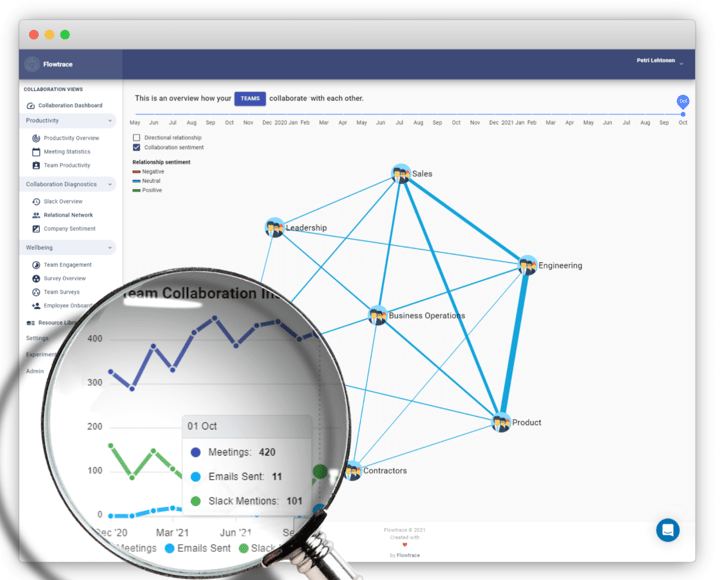After managing a number of small and medium-sized teams in different industries, my main management focus was on standard company performance metrics. This would include in-person quarterly reviews, sales figures, and measuring task completion rates.
However, this led me to think, can team members be empowered to perform more effectively through a data-driven approach?
Is a Metric Driven Team Effective?
I believe that setting up a metric-driven team involves setting key performance indicators (KPIs) for individuals and teams to measure their progress against. This is very effective as it provides a way for both the employee and the manager to check their performance progress at any given time, and also allows managers to track performance over time. I've used this method in the past with good results.
However, I think there needs to be other forms of management that empower employees rather than management that is focused on metrics and an authoritarian style, as people perform better when they feel that there's more than just task completion involved in their role. This is where I started to look into a more data-driven approach.
Using metrics to manage a team, doesn't really identify key aspects of productivity and performance, only a basic output of success/failure. To truly manage a team effectively, I needed to understand the effectiveness of tasks, effort percentages, output levels, and other various metrics. However, to understand this data is one thing, but to help the team understand it unlocked a completely different team.
Can Team Management Be Data Driven?

To truly measure a team's level of performance, I needed to switch from a metric-driven management approach, to a data-driven one. This involved creating custom reports for my team based on different variables such as sales numbers, revenue generated, tasks completed etc. My main focus was on which metrics had the most influence on performance and goal attainment after a set time period.
Using data to understand which aspects of productivity have the biggest impact is an effective way to manage teams. Even though it may take considerable effort in the beginning to measure and collect this information, it will allow managers to identify specific areas in their reports with actionable insights. This will ultimately give them control of their ways of working, and ultimately, own the results.
Despite believing that teams can't be managed effectively with just metrics, I must admit that they remain an integral part of both management and analysis, as it's difficult to draw conclusions from only data. For managers, though, metrics should be considered as one of many factors needed to manage a team successfully, and not the sole method through which teams are driven towards high performance.
It is important to understand that a data-driven team doesn’t focus on the manager, this data needs to be shared with the team in order to fully utilize it. A good manager will use the data to improve dynamics and achieve results themselves, a great manager will empower the team to use this data and achieve even more.

Is It Possible To Manage a Team By Data Only?
I believe that using data to empower teams is the way forward in today's highly connected and competitive society. This is because, with the internet and cloud technology today, there's a vast amount of data available at an organization's fingertips which, when correctly analyzed, will allow employees, and managers alike, to have a comprehensive view on all aspects of performance.
Effective team management requires having access to information about how each individual performs over time to ensure that they are constantly meeting organizational expectations. This can be done by making sure that your team members have clear KPIs which track key metrics such as work quality, client feedback scorecards, etc., so you have reliable ways of knowing where to improve your team’s strengths and weaknesses.
Importance of a Data-Driven Team
As there's a vast amount of data available at our fingertips today, it's important to use that information effectively in order to manage teams successfully.
Data-driven team management is necessary when working to improve employee productivity through efficiency and effectiveness. This means that you can identify obstacles, issues, and slowdowns impacting your entire workforce objectively, by looking at their performance over time. This will give you the ability to identify poor-performing individuals or, even better, understand what needs to be done in order for them to improve.
This not only helps managers accurately pinpoint where they need to focus their efforts when attempting to help out employees, but also allows them to create plans tailored specifically towards each individual. Once created, this kind of plan should be implemented on a regular basis.
How to Use Data to Improve Team Collaboration
Using data to improve team collaboration is essential, and managers need to be willing to share that data with their employees in order to take the right steps. Flowtrace actually makes handling this data simple.
There are several ways that you can use data to improve team collaboration:
- Building dashboards that show key metrics such as goals, progress, and output. These should be available on team, and individual level for self-improvement basis.
- Sharing employee surveys, and results, so teams can see how they're performing compared to others.
- Look for patterns in the data. If one team is always connecting the other team over the other, then there might be a communication issue and lack of cooperation. You can then focus on removing communication barriers and reducing communication friction.
- Identify areas where teams need improvement and focus on those areas. For example, if one collaboration channel is considerably below average, it could be an internal, external, or management level improvement area.
- Use data to troubleshoot problems between teams. Identify the information silos, and broken communication lines. If there is an issue, try to find the root of the problem and fix it.
 A way to measure this is by looking at the communication flow between teams. There are a few different ways to do this:
A way to measure this is by looking at the communication flow between teams. There are a few different ways to do this:
- Visualizing how the team use communication tools. This allows you to identify where cross-team collaboration could be made more efficient and effective.
- Understanding how well interactions between teams function, like the time it takes to respond or if the exchange is balanced.
- Analyzing the context where information sharing takes place, like project management tools, document tools, public chat communicatiomeasuren, and meeting calendars.
By tracking these information opportunities, you can get an idea of how well different teams are working together. If there is a lot of back and forth chatter, then it's likely that the teams aren't communicating effectively.
On the other hand, if there are fewer opportunities to share information between teams, then it's possible that they're not collaborating properly.
While measuring team performance, it's important to also measure collaboration between teams. This will give you a more well-rounded view of how your team is performing.
Focusing on Data with Flowtrace
After identifying the importance of a data-driven approach in my management role, I needed a solution that could help me put this data into perspective and truly understand how to use the data.
That's when I came across Flowtrace.
Flowtrace analyses data from many productivity and collaboration tools, like Google Docs, calendars, code repositories like GitLab, GitHub, client tools like Front, Intercom, and project management tools like Jira, Trello. This allows users to get a quick read on the situation. In just a few minutes, I could see exactly what was going on with my team and make necessary changes.
Flowtrace can be used by anyone because it's simple and intuitive - anyone from managers to office workers will find Flowtrace fast and easy to use.
What's even better is that it's actually engaging for everyone involved! All you have to do is open up the app, log in through your existing tools (Slack, Google Docs, etc.), and start downloading the data!
By doing this over time, Flowtrace builds a rich history of data that can then be analyzed or into reports for further evaluation.

Conclusion
Using data to manage a team can be difficult, but it's important to implement a system that allows you to take specific steps towards improvement. The right tools and processes can help you identify problems and quickly resolve them, so your team is always operating at optimal performance.
Using Flowtrace as part of the process will arm you with all the necessary information and insight required to extract value from your collaboration efforts. By getting started now, managers will be able to experience the benefits of using Flowtrace very soon.